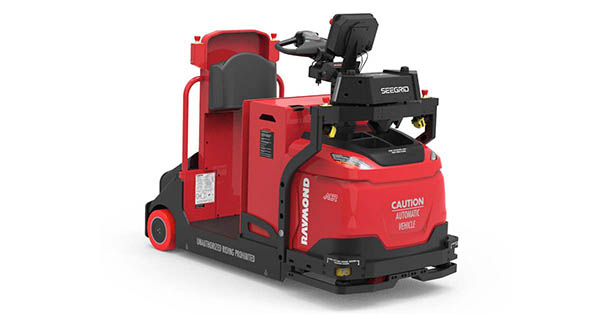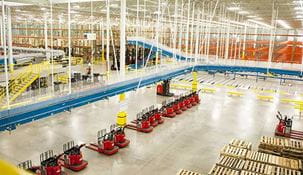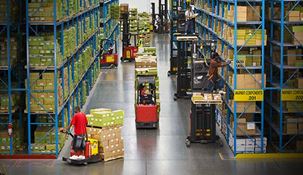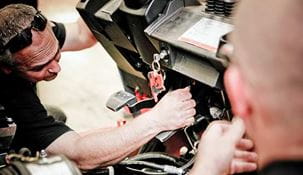-

Raleigh Autonomous Guided Vehicle (AGV)
Carolina Handling sells, installs and maintains Autonomous Guided Vehicles (AGVs) and other AS/RS equipment in North Carolina and across the Southeast. Our automation specialists can help you find the perfect solution from world class AS/RS manufacturers like Modula.
North Carolina Autonomous Guided Vehicle (AGV) Supplier
What is an AGV?
Often referred to as autonomous guided vehicles or self-guided vehicles, automated guided vehicles (AGVs) are material handling systems or goods transporters that proceed autonomously around the floors of a warehouse, factory or DC without an onboard operator.
What are Automated Guided Vehicles used for?
Popular AGV applications include retrieval and storage in storage facilities and distribution centers, normally in support of order picking. They are also put to use for transport of basic materials, work-in-process and finished goods in factories.
What are the main advantages of Self-Guided Vehicles?
- Reduced Labor Costs: AGVs can substantially minimize labor expenses. A one-time expenditure can get rid of the continuous costs of wages, taxes and benefits connected with a full-time worker.
- Increased Safety: Contemporary AGVs use advanced electronic cameras, lasers or other sensors that enable them to "see" and react to their environment instantaneously. Humans can get fatigued or distracted, whereas machines do not. AGVs can likewise be utilized in extreme conditions or around dangerous materials where personal safety is at risk.
- Increased Productivity & Accuracy: AGVs can work around the clock, never needing breaks or getting fatigued. They can make distant treks around a large building effortlessly. They likewise don't make the types of errors that human workers are prone to making.
- Modularity: Most AGV systems can be introduced slowly, replacing a few jobs incrementally without an enormous expenditure in advance. As automation needs expand, more AGVs can quickly be introduced to the system.
How do AGVs work?
AGVs are directed by a combination of sensor-based management systems and computer programs. They can maneuver securely through a warehouse or production facility by utilizing impediment detection bumpers and following thoroughly vetted courses while using precisely regulated acceleration and deceleration.
AGV navigation is usually supervised by one of these types of systems:
- Vision guidance: Cameras capture the AGV's surroundings, and the vehicles use these logged images to navigate. Vision guidance is standalone, and as a result, no adjustment is needed to a production facility or warehouse infrastructure for this type of navigation.
- Laser target navigation: With laser-based equipment, reflective tape is mounted to racks, walls, posts and other stationary bodies. AGVs use laser transmitters to rebound light off of these reflectors and then utilize the proximity and angle of objects to maneuver.
- LiDAR: LiDAR solutions send laser bursts to measure the distance between the AGV and articles in its vicinity. This data is utilized to develop a comprehensive map of the setting. In similarity to vision guidance, no adjustment of a facility is required.
- Inertial navigation: Transponders implanted into facility flooring route AGVs along a defined track.
- Wired navigation: These systems utilize wire pathways embedded into a warehouse or factory floor surface. The wire sends a signal that an AGV identifies via a sensing unit or antenna system.
- Magnetic guide tape: This kind of AGV uses magnetic sensors and conforms to a course laid out by magnetic tape.
What are the various types of Autonomous Guided Vehicles?
There are numerous types of automated guided vehicles. Many AGVs are similar to other human-operated vehicles yet are developed to function without continuous human intervention or assistance.
- Forklift AGVs: Forklift automatic guided vehicles are an often-used kind of AGV in warehouses. They're designed to transport pallets without the supervision of a human driver.
- Automated Guided Carts: An automatic guided cart is probably the most rudimentary type of AGV. They can carry all types of products, from entire pallets to small parts. AGCs are regularly used in storage, sorting and cross-docking applications.
- Tugger AGVs: Towing or "tugger" AGVs pull unpowered, load-carrying carts trailing them in a train-like setup. These kinds of automatic guided vehicles are frequently utilized for moving heavy loads over long distances. Many times, they are set to make multiple pickups and drop-offs along their course.
- Unit Load Handlers: Unit load handlers carry solitary payloads like specific items or a discrete pallet or tote.
- Heavy Burden Carriers: These are utilized for extremely heavy loads like plates, castings or coils.
Automated Guided Vehicle Supplier Near Me
If you'd like a complete analysis of AGV possibilities for your warehouse, DC or production center, you can talk to an expert at Carolina Handling.
-
-
Proudly serving
Raleigh, Durham,
Cary, Morrisville,
Wake Forest, Apex,
Holly Springs, Garner,
Fuquay-Varina, Clayton,
Knightdale, Chapel Hill,
Jacksonville, Rocky Mount
Wilson, Goldsboro,
and the entire
State of North Carolina
You May Also Like:

Automation
Carolina Handling can help you automate every aspect of your warehouse operation to increase efficiency.
Learn More

Optimization
Optimize everything in your warehouse to improve productivity and reduce operating costs.
Learn More

Warehouse Products
Looking for the right product for your operation? We have everything you need to do business in stock.
Learn More

Service Maintenance
Providing superior lift truck service and maintenance for our customers is Carolina Handling's highest priority.
Learn More


